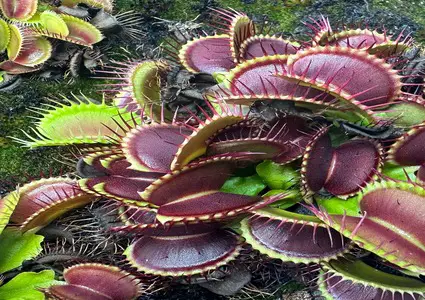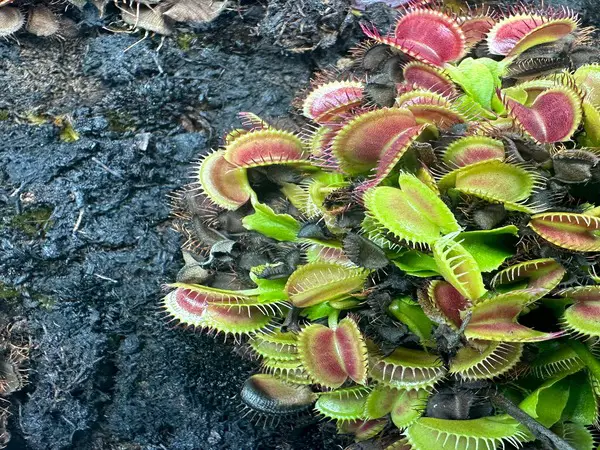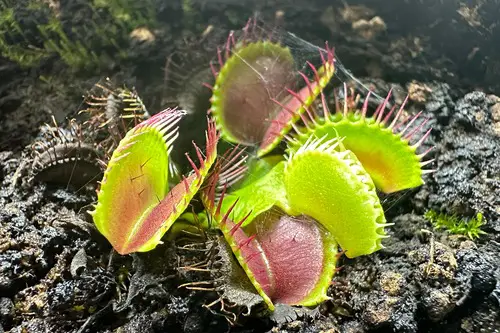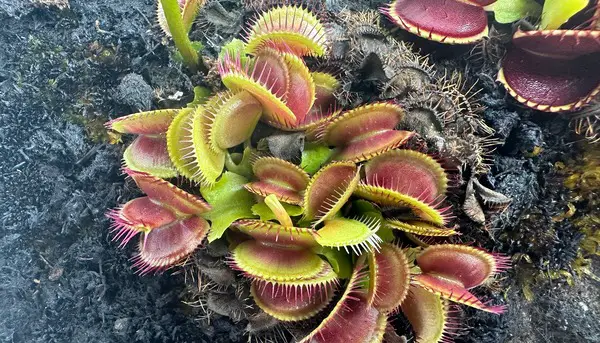You can determine the health of your Venus Fly Trap by examining its physical appearance. The size of the plant together with the colors alone can give you a lot of valuable information.
Healthy Venus Fly Traps exhibit bright colors and large traps for capturing bugs. And during the growing season they often propane and produce clones.
Below you will find some clear signs a Venus Fly trap is healthy with some tips to ensure you make an accurate assessment.
Bright colored leaves
Venus fly traps characterize with deep and shiny colors. Healthy plants have bright green and red leaves that do not appear faded.
Unhealthy plants will often start looking yellow due to mineral saturation in the soil, or overwatering.
Not all Venus Fly traps have the same color intensity, however, changes in the appearance of the plant can be a sign of good or bad health.

Red coloring inside the traps
Some Venus Fly Traps can develop deep burgandy colors inside their leaves. The red coloring in the leaves is overall a sign of good health. The deeper the color the better.
When plants do not receive enough lighting they will often lose the red color of their leaves as they are experience deficient growing conditions.
If you notice your plant has started to fade and lose its colors, consider increasing the light intensity or time under sunlight. Venus Fly Traps thrive in sunny conditions for 10+ hours a day.
Straight non “droopy” leaves
When Venus Fly Traps do not receive enough sunlight or water they often start to wilt. Their leaves bend and arch.
Healthy Venus Fly Traps should have straight leaves. Such leaves might grow close to the ground or straight up depending on the season, but they should always be perky and not droopy.
Here is a guide on how to fix a droopy Venus Fly trap
Working bug-catching traps
The leaves of a Venus Fly trap have traps to capture insects.
Inside the traps there are some thin filaments that are called trigger hairs. When the trigger hairs sense movement twice, they send a signal and the trap closes.
The traps of the plant should work when the plant is healthy. If something touches the trigger hairs, they should in most cases close.
It is normal for a leaf to stop working, but if the whole plant is not reacting, then there is a problem. It is often a sign of poor lighting. Often, Venus Fly Traps stop activating their traps to save energy due to poor growing conditions.

Several healthy leaves at a time
Venus Fly Traps will lose and produce leaves as they grow and develop.
Overall, a substantial number of leaves will help them with photosynthesis and to trap insects. Most Venus Fly Traps grow 3-7 leaves at a time.
Promote leaf growth by ensuring your plant got dormant during the winter and by providing substantial water and light throughout the year.

Large traps in all leaves
Venus Fly Traps grow traps at the end of every leaf.
Healthy plants grow traps close to an inch in size when they are of mature age (over 3-4 years old).
This chart can help you assess the health of your plant.
When Venus flytraps are thriving they develop large traps and focus on capturing insects. In the contrary, if they are struggling, they reduce the size of their traps. Dying plants will often lose their traps completely.
Age | Trap Size |
| Seedlings | Tiny |
| 1-2 years | 1/8 inch |
| 2-3 years | 1/4 inch |
| 3 years | 1/2 inch |
| 4+ years | 1 – 2 inches |
Promoting trap development is not very hard. The focus should be in two things: plenty of lighting and proper watering. This guide can help you master both:
Rhizome divisions
Venus Fly Traps reproduce through different mechanisms. Some of them are a sign of health.
During the spring and summer season, fit Venus Fly trap often produce rhizome divisions. They clone themselves and produce additional plants from their bulb.
Here is an example of a rhizome division. You can notice smaller leaves in some areas and over 18 leaves in total.

Venus Fly traps have 3-7 leaves, if you can count a lot more than that, it means you probably own multiple plants already!
Leaves with long petioles
Sometimes the petioles of a Venus Fly trap with widen as the plant struggles to capture enough sunlight.
When Venus flytraps are in good shape, they develop long and slim petioles. Wide petioles are not a positive trait.
The actual dimensions of the leaf will vary according to their specific variety, but any widening of the petiole is usually a warning sign!
Fully formed leaves
Pest will often cause leaf deformation problems which need to be addressed right away to determine the severity.
Venus Fly Traps have a very unique shape which is preserved from seedlings into adulthood. Fully form and even leaves are a sign of good growing conditions.
Now that you have learned the signs of a healthy plant, I would recommend you to go over the most important care considerations.
This list will help you ensure your set up is optimal! remember, when the conditions are right, Venus fly traps can live for many many years (or decades!) 🙂
Light: Optimally they should receive 12 hours of sunlight, and the minimum is 6 hours of light. The light source might be natural light or artificial lighting (plant lights)
Water : Venus flytraps must be watered with pure water only, such as rainwater, distilled water, and reverse osmosis water. Tap water and bottled water kill carnivorous plants.
: Venus flytraps must be watered with pure water only, such as rainwater, distilled water, and reverse osmosis water. Tap water and bottled water kill carnivorous plants.
The soil of the plant must always remain moist. Always keep the ground humid, but do not flood. Venus flytraps do not grow in swamps.
Soil: Employ nutrient-free soil for carnivorous plants. Never employ enriched soil, full of fertilizers. This article covers many soil options for Venus flytraps.
covers many soil options for Venus flytraps.
Feeding: Venus flytraps do not need to capture insects to survive, but they benefit from them greatly. Place Venus flytraps outdoors, and they will have plenty of access to food. Also, consider feeding your plant to provide extra nutrients.
Fertilizers: Do not fertilize Venus flytraps. The chemicals in the fertilizers can hurt the plant
Flowers: After reaching maturity, Venus flytraps start producing flowers every spring. Skipping it allows for further growth and development.
Dormancy: Venus flytraps must undergo a dormancy period for 2-3 months during the winter. Ensure your plant will experience this resting period by placing them in a cold location. For example, outdoors, in a cold garage, or porch.
